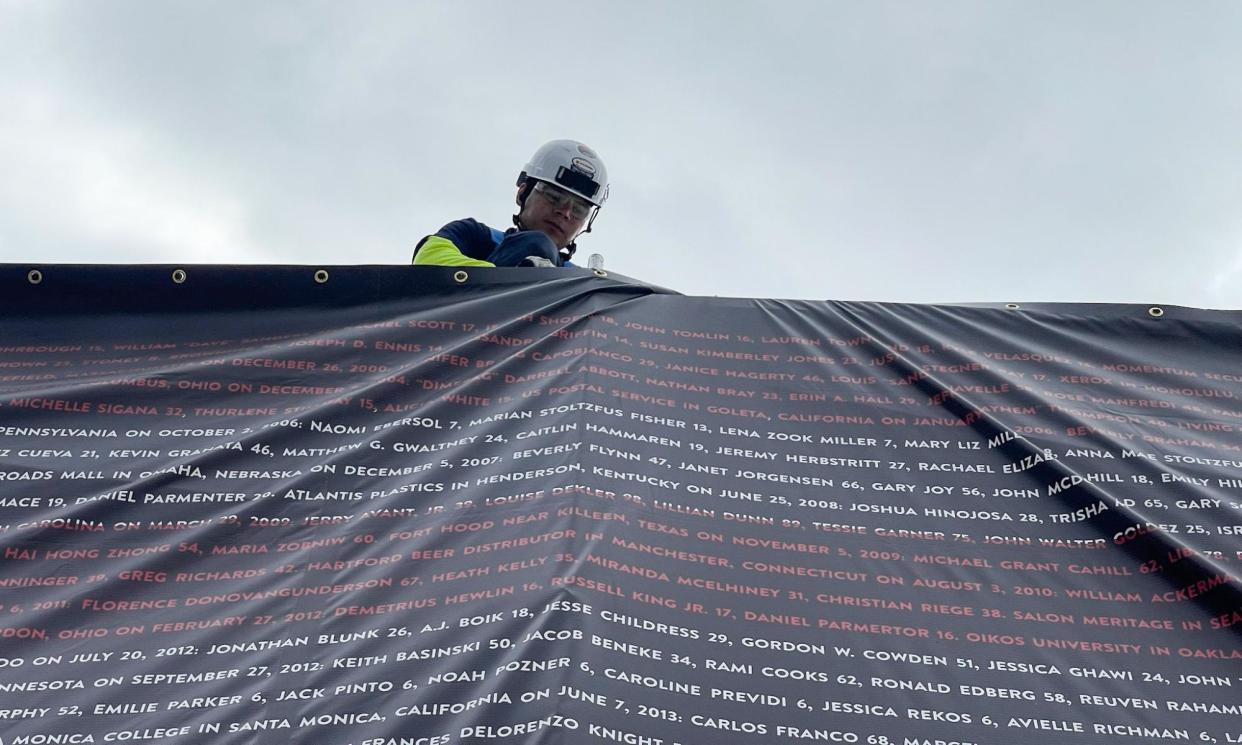‘A handgun in every nightstand’: art installation shines light on US gun violence

On Capitol Hill there is no shortage of politicians who wrap themselves in the Stars and Stripes and founding documents when seeking to defend the right to bear arms. But any who walk up Pennsylvania Avenue in the next 10 days will be confronted by an inversion of these patriotic symbols and an urgent plea to tackle gun violence.
Alienable right to life is a public art installation at Freedom Plaza that features a huge American flag bearing the names of 1,039 people killed in mass shootings since the Columbine high school massacre 25 years ago.
Related: Tennessee passes bill to allow teachers to carry concealed guns despite protests
“I, sadly, have left one panel blank on the north-east corner of this artwork in case there is yet another mass shooting while this art is on exhibition,” artist Suzanne Brennan Firstenberg said on Friday at a rainy launch event attended by the congressional Democrats Nancy Pelosi and Jamie Raskin and gun safety advocates.
The piece, made of scaffold wrapped with vinyl, is 35ft long, 25ft high and 12ft wide and secured by 32,000lb of ballast. Nestled behind the flag is a giant facsimile of the Declaration of Independence, which takes the assertion that all men are created equal with certain unalienable rights, magnifies the word “unalienable” and puts a red cross through “un”, leaving only “alienable”.
Nearby is an interactive circular mural, representing an upside down Stars and Stripes (a sign of imminent danger or distress) for visitors to share personal stories.
“Kids shouldn’t be afraid to go to school!” one says.
The structures are surrounded by trappings of the nation’s capital: historic quotations about Washington inscribed on the upper terrace; a statue of Casimir Pulaski, a general in the Continental army, on horseback; the executive office of the mayor and the council of the District of Columbia; the National Theatre, about to stage Andrew Lloyd Webber and Tim Rice’s Jesus Christ Superstar.
In her remarks on Friday, Firstenberg, 64, described her motives for creating alienable right to life, noting that gun violence has become the leading cause of death for American children.
“America has become a dangerous place,” she said. “It used to be a place where we talked about a chicken in every pot and now it’s a handgun in every nightstand.
“This art is meant to broaden the dialogue regarding gun access from a singular focus on the right to bear arms to the individual right to life that emanates from the Declaration of Independence. I’m just going to go there, folks: if people are willing to fight for the rights of frozen embryos in Alabama, we should fight for the rights of America’s children.”
The artist told how a friend named Andrea recently bought a 9mm handgun and used it to end her life. Firstenberg has added her name to the circular mural, where the public are invited to use black stickers to add their reflections or the names of loved ones lost.
“The image of our American flag will disappear under those stories of gun violence,” Firstenberg said.
Alienable right to life, privately funded, was made possible with the help of the National Park Service and DowntownDC Business Improvement District, and will be on display until 20 May.
Firstenberg added: “Let us all commit that we will not let our children die in car seats, in math class, at the movies, or sitting on a kerb watching a Fourth of July parade. We must stop adding names to the flag.”
The launch event heard Pelosi and Raskin praise Firstenberg’s work and urge Congress to do more to curb gun deaths, including legislation to ban assault weapons. Chaplain Denise Reid recounted how her life has been affected by gun violence for half a century including when her son, Tavon Waters, was shot at a traffic light in 2006 and left paralysed from the neck down. He died from his injuries three years later at the age of 25.
Reid, a deputy lead of the Baltimore city chapter of the group Moms Demand Action, said: “A senseless act of violence took my precious child from me and senseless acts of gun violence continue to plague our communities. How far to the sky would this flag need to be to include all the names of those needlessly lost? As this art beautifully conveys, the Declaration of Independence clearly expressed 248 years ago that everyone has the right to life, liberty and the pursuit of happiness.”
Firstenberg is known for poignant installations such as In America: Remember, which blanketed the National Mall with 701,000 white flags for 17 days in 2021, in memory of victims of the coronavirus pandemic. Their stories are now being entered into a database at George Washington University and some of the flags are preserved at her studio in Bethesda, Maryland.
In an interview, the artist said she hoped the scale and prominence of her work can transcend political divisions.
“Words are going unheard because we’re all existing more and more every day in our own echo chambers so public art is one of the few ways in which we can reach people without prior intention on their part of choosing what information they get,” she said.
“Public art gives us a way to have free expression and hope that people see it. Will it change minds? I can only hope. We have to start comparing ourselves to other countries rather than just thinking we’re the best. We have to pull back and understand what’s happening here.”


